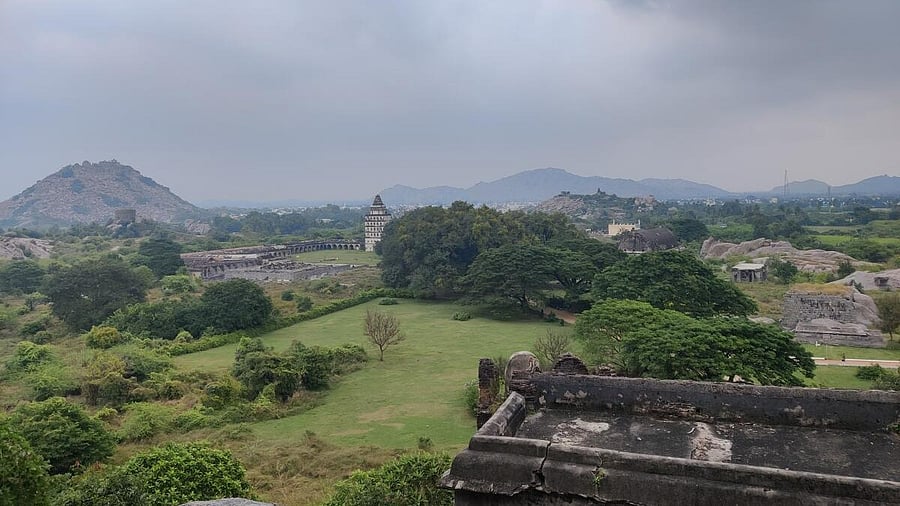
A panoramic view of Gingee fort.
Photos by Author
On our way back from Puducherry to Bengaluru, we made an impromptu decision to stop over at the Gingee Fort. Set amidst beautiful natural rocky terrains, this is a unique location frequented by trekkers and adventure enthusiasts.
But what stands out incredibly is its historical significance. The first thing that we noticed upon entering was the astounding vastness of the enclosure. Spanning over three hillocks, the fort complex is known to hold an area of about 11 square kilometres that is confined by massive walls and cliffs all around. As it is ascertained, Gingee Fort was extremely well planned and secure, so much so that Chatrapathi Shivaji had himself claimed that it was the most impregnable fort. We set out to trek the Rajagiri Hill, which is the highest among the three. A series of over 1,000 steps would usher us to the citadel at the top. Along our way, we came across several structures like stables, granaries, temples and shrines among others.
A seven-storeyed Kalyana Mahal adjacent to a large stepped tank, a gymnasium for soldiers, a special audience hall and a Magazine (for storage of ammunition) were some of the most conspicuous architectures that served interesting purposes. Today, all of them continue to exist as reminiscent of a huge township that once flourished in the vicinity. Our ascent was getting strenuous at some stretches, but the cool cloudy weather kept us going. And the panoramic views were promising as well. It is said that the credit for the initial hilltop fortification goes to the Konar kings who recognised the potential of the area many centuries ago. However, the surrounding walls and all the other constructions were done subsequently.
Between the 14th and 18th centuries, the fort was consecutively seized and controlled by the Vijayanagara kingdom, Gingee Nayakas, Bijapur Sultans, Marathas, Mughals, French and the British. Each of these dynasties had revamped the fort during their tenure contributing to the magnificence it had attained. Due to the elevated domain, the region was strategically important to ward off the invading enemies. Gingee’s proximity to Chennai and the eminent port of Puducherry was an added vantage point. After all, it was abandoned in the 19th century. What we see today are the ruins of a fort that had witnessed its fair share of glory along with various invasions, wars and valour.
Presently, Gingee Fort is maintained by the ASI and is a classic tourist attraction. For the moment, as the cloudy day eventually turned out to be rainy, our trek had to be cut short. Unfortunately, we couldn’t make it to the summit. There is always a next time! Hopefully, then we would also be able to reach out towards Krishnagiri Hill, which is another substantial part of this monumental fort complex.